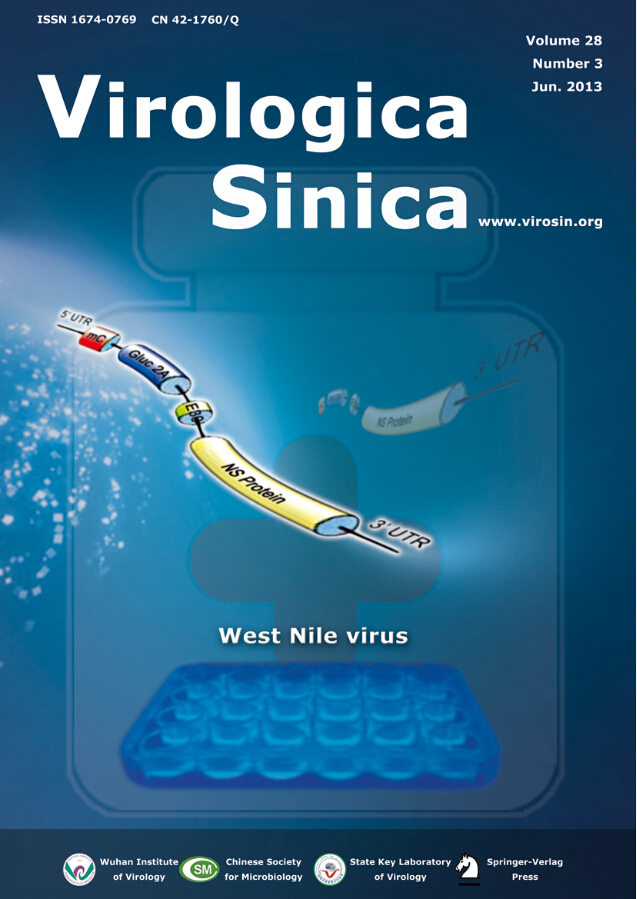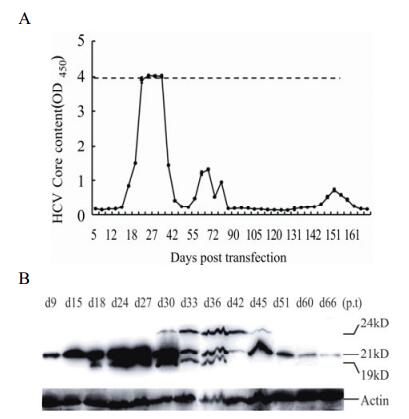-
Akuta N, Suzuki F, Hirakawa M, Kawamura Y, Yatsuji H, Sezaki H, Suzuki Y, Hosaka T, Kobayashi M, Saitoh S, Arase Y, Ikeda K, Chayama K, Nakamura Y, and Kumada H. 2010. Amino acid substitution in hepatitis C virus core region and genetic variation near the interleukin 28B gene predict viral response to telaprevir with peginterferon and ribavirin. Hepatology, 52: 421-429.
doi: 10.1002/hep.23690
-
Akuta N, Suzuki F, Hirakawa M, Kawamura Y, Yatsuji H, Sezaki H, Suzuki Y, Hosaka T, Kobayashi M, Saitoh S, Arase Y, Ikeda K, Chayama K, Nakamura Y, and Kumada H. 2012. Amino Acid Substitution in HCV Core Region and Genetic Variation near the IL28B Gene Affect Viral Dynamics during Telaprevir, Peginterferon and Ribavirin Treatment. Intervirology, 55: 417-425.
doi: 10.1159/000323526
-
Alter M J. 1997. Epidemiology of hepatitis C. Hepatology, 26: 62S-65S.
doi: 10.1002/(ISSN)1527-3350
-
Blaney J E, Jr., Johnson D H, Manipon G G, Firestone C Y, Hanson C T, Murphy B R, and Whitehead S S. 2002. Genetic basis of attenuation of dengue virus type 4 small plaque mutants with restricted replication in suckling mice and in SCID mice transplanted with human liver cells. Virology, 300: 125-139.
doi: 10.1006/viro.2002.1528
-
Eng F J, Walewski J L, Klepper A L, Fishman S L, Desai S M, McMullan L K, Evans M J, Rice C M, and Branch A D. 2009. Internal Initiation Stimulates Production of p8 Minicore, a Member of a Newly Discovered Family of Hepatitis C Virus Core Protein Isoforms. J Virol, 83: 3104-3114.
doi: 10.1128/JVI.01679-08
-
Garcia-Sastre A, Tellinghuisen T L, Foss K L, and Treadaway J. 2008. Regulation of Hepatitis C Virion Production via Phosphorylation of the NS5A Protein. PLoS Pathogens, 4: e1000032.
doi: 10.1371/journal.ppat.1000032
-
Heller T. 2005. An in vitro model of hepatitis C virion production. Proc Natl Acad Sci USA, 102: 2579-2583.
doi: 10.1073/pnas.0409666102
-
Houghton M, and Abrignani S. 2005. Prospects for a vaccine against the hepatitis C virus. Nature, 436: 961-966.
doi: 10.1038/nature04081
-
Hussy P, Langen H, Mous J, and Jacobsen H. 1996. Hepatitis C virus core protein: carboxy-terminal boundaries of two processed species suggest cleavage by a signal peptide peptidase. Virology, 224: 93-104.
doi: 10.1006/viro.1996.0510
-
Kopp M, Murray C L, Jones C T, and Rice C M. 2010. Genetic analysis of the carboxy-terminal region of the hepatitis C virus core protein. J Virol, 84: 1666-1673.
doi: 10.1128/JVI.02043-09
-
Lai M M, and Ware C F. 2000. Hepatitis C virus core protein: possible roles in viral pathogenesis. Curr Top Microbiol Immunol, 242: 117-134.
-
McLauchlan J. 2000. Properties of the hepatitis C virus core protein: a structural protein that modulates cellular processes. J Viral Hepat, 7: 2-14.
doi: 10.1046/j.1365-2893.2000.00201.x
-
McLauchlan J, Lemberg M K, Hope G, and Martoglio B. 2002. Intramembrane proteolysis promotes trafficking of hepatitis C virus core protein to lipid droplets. EMBO J, 21: 3980-3988.
doi: 10.1093/emboj/cdf414
-
Moriya K, Yotsuyanagi H, Shintani Y, Fujie H, Ishibashi K, Matsuura Y, Miyamura T, and Koike K. 1997. Hepatitis C virus core protein induces hepatic steatosis in transgenic mice. J Gen Virol, 78(Pt 7): 1527-1531.
-
Moriya K, Fujie H, Shintani Y, Yotsuyanagi H, Tsutsumi T, Ishibashi K, Matsuura Y, Kimura S, Miyamura T, and Koike K. 1998. The core protein of hepatitis C virus induces hepatocellular carcinoma in transgenic mice. Nat Med, 4: 1065-1067.
doi: 10.1038/2053
-
Moriya K, Nakagawa K, Santa T, Shintani Y, Fujie H, Miyoshi H, Tsutsumi T, Miyazawa T, Ishibashi K, Horie T, Imai K, Todoroki T, Kimura S, and Koike K. 2001. Oxidative stress in the absence of inflammation in a mouse model for hepatitis C virus-associated hepatocarcinogenesis. Cancer Res, 61: 4365-4370.
-
Okamoto K, Mori Y, Komoda Y, Okamoto T, Okochi M, Takeda M, Suzuki T, Moriishi K, and Matsuura Y. 2008. Intramembrane Processing by Signal Peptide Peptidase Regulates the Membrane Localization of Hepatitis C Virus Core Protein and Viral Propagation. J Virol, 82: 8349-8361.
doi: 10.1128/JVI.00306-08
-
Okuda M, Li K, Beard M R, Showalter L A, Scholle F, Lemon S M, and Weinman S A. 2002. Mitochondrial injury, oxidative stress, and antioxidant gene expression are induced by hepatitis C virus core protein. Gastroenterology, 122: 366-375.
doi: 10.1053/gast.2002.30983
-
Pawlotsky J M. 2004. Pathophysiology of hepatitis C virus infection and related liver disease. Trends Microbiol, 12: 96-102.
doi: 10.1016/j.tim.2003.12.005
-
Sauter D, Himmelsbach K, Kriegs M, Carvajal Yepes M, and Hildt E. 2009. Localization determines function: N-terminally truncated NS5A fragments accumulate in the nucleus and impair HCV replication. J Hepatol, 50: 861-871.
-
Shih C M, Chen C M, Chen S Y, and Lee Y H. 1995. Modulation of the trans-suppression activity of hepatitis C virus core protein by phosphorylation. J Virol, 69: 1160-1171.
-
Suzuki R, Matsuura Y, Suzuki T, Ando A, Chiba J, Harada S, Saito I, and Miyamura T. 1995. Nuclear localization of the truncated hepatitis C virus core protein with its hydrophobic C terminus deleted. J Gen Virol, 76(Pt 1): 53-61.
-
Suzuki R, Sakamoto S, Tsutsumi T, Rikimaru A, Tanaka K, Shimoike T, Moriishi K, Iwasaki T, Mizumoto K, Matsuura Y, Miyamura T, and Suzuki T. 2005. Molecular determinants for subcellular localization of hepatitis C virus core protein. J Virol, 79: 1271-1281.
doi: 10.1128/JVI.79.2.1271-1281.2005
-
Wakita T, Pietschmann T, Kato T, Date T, Miyamoto M, Zhao Z, Murthy K, Habermann A, Kräusslich H-G, Mizokami M, Bartenschlager R, and Liang T J. 2005. Production of infectious hepatitis C virus in tissue culture from a cloned viral genome. Nature Medicine, 11: 791-796.
doi: 10.1038/nm1268
-
Walewski J L, Keller T R, Stump D D, and Branch A D. 2001. Evidence for a new hepatitis C virus antigen encoded in an overlapping reading frame. RNA, 7: 710-721.
doi: 10.1017/S1355838201010111
-
Yeh C T, Lo S Y, Dai D I, Tang J H, Chu C M, and Liaw Y F. 2000. Amino acid substitutions in codons 9-11 of hepatitis C virus core protein lead to the synthesis of a short core protein product. J Gastroenterol Hepatol, 15: 182-191.
doi: 10.1046/j.1440-1746.2000.02066.x
-
Zhong J. 2005. Robust hepatitis C virus infection in vitro. Proceedings of the National Academy of Sciences, 102: 9294-9299.
doi: 10.1073/pnas.0503596102
-
Zhong J, Gastaminza P, Chung J, Stamataki Z, Isogawa M, Cheng G, McKeating J A, and Chisari F V. 2006. Persistent Hepatitis C Virus Infection In Vitro: Coevolution of Virus and Host. J Virol, 80: 11082-11093.
doi: 10.1128/JVI.01307-06












